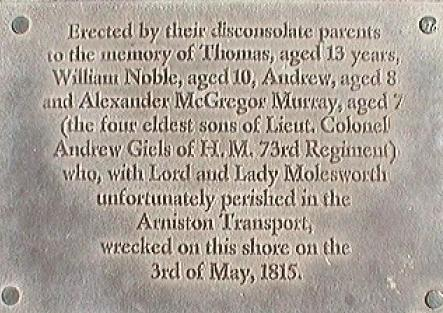The Arniston was built on the River Thames, England in 1794. It was a three-decked and three-masted British East Indiaman vessel and was first used as a trading ship, completing eight successful voyages between India and China from November 1794 to June 1813 (Wreck of the Arniston | Time and Navigation, n.d.). Thereafter it was recommissioned to serve as a troop transport in 1813 or 1814 between England, India and Ceylon (now Sri Lanka) for the Royal Navy.
The Arniston embarked on its last journey in April 1815 from Pont de Galle in Ceylon, with a fleet of ships, including six Indiamen and His Majesty’s warships. Aboard were injured soldiers and sailors from the British campaigns in Kandia and Ghurka, India. There were a total of 378 people on board, including 14 women and 25 children (Story of the HMS Arniston | Xplorio Arniston, n.d.).
On 30 May 1815, the Arniston separated from the rest of the fleet as they hit a storm on the South African coast, off the Agulhas Bank. This was particularly worrisome as the Arniston did not have a chronometer, a precision timepiece that is used similarly to a compass to know a ship’s location because Captain George Simpson could not afford one, and the company who owned the Arniston thought it was too expensive (Wreck of the Arniston | Time and Navigation, n.d.). As a result, the Arniston relied on the other ships in its fleet for signals they used to determine longitude.
As Captain George Simpson was unable to determine an exact location, he told the crew to head north. The next day they saw breaking waves, and they noticed their mistake. They cut anchor cables in an attempt to turn the ship around, but it was too late. This is when they crashed into the Lagullos Reef, near the Waenhuiskrans coast in South Africa, and the Arniston soon began to break apart (Wreck of the Arniston | Time and Navigation, n.d.). Only six people survived this tragedy.
The survivors managed to find a farmer’s son days after the accident. The rest of the Arniston’s passengers washed up until 11 July 1815 and were buried behind the dunes (Story of the HMS Arniston | Xplorio Arniston, n.d.). A beacon was built as a warning to passing ships after the Arniston and another ship, the Queen of the Thames, met its fate on the shores of Waenhuiskrans (Story of the HMS Arniston | Xplorio Arniston, n.d.). By 1825, in an attempt to prevent such accidents, all Royal Navy ships had a maritime chronometer on board. The tragedy became so well-known and connected to Waenhuiskrans, the town near the wreck site, that they renamed it Arniston (Story of the HMS Arniston | Xplorio Arniston, n.d.). Another memorial plaque was built by Colonel Giels’ wife. Colonel Giels, along with his four children, died during the accident (Story of the HMS Arniston | Xplorio Arniston, n.d.).

The African Maritime Museum and the National Monuments Council (NMC) have surveyed and recorded a wooden wreck, believed to be the Arniston. This site is the first to fall under the National Monuments Council Act for shipwrecks (Gericke, 1983). This means that the ship, along with any other ship older than 50 years, is protected from salvage and is legally protected as a heritage site.